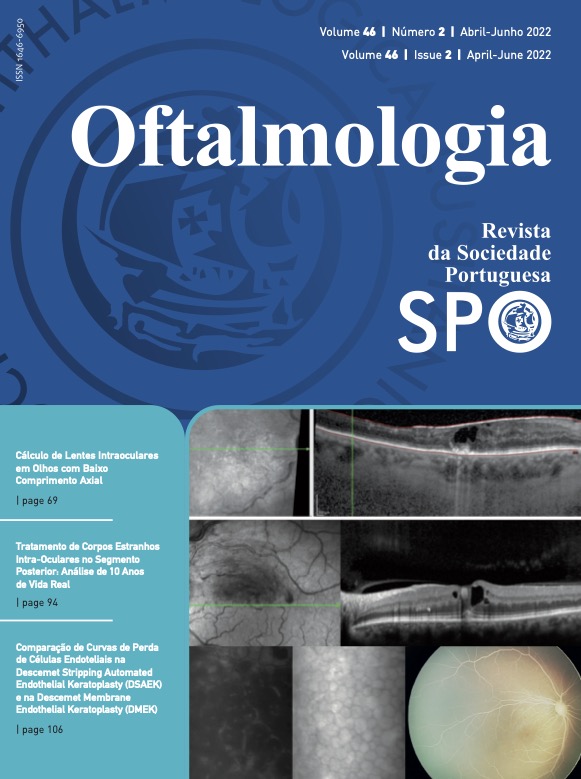Management of Intraocular Foreign Bodies in the Posterior Segment: 10 Years Real World Analyses
DOI:
https://doi.org/10.48560/rspo.25270Keywords:
Endophthalmitis, Eye Foreign Bodies/complications, Eye Injuries, Penetrating/complications, VitrectomyAbstract
INTRODUCTION: Ocular traumas with intraocular foreign bodies (IOFB) can have serious ocular complications, such as retinal detachment and endophthalmitis that can greatly affect the visual outcome. Pars plana vitrectomy (PPV) is the most commonly used technique to remove IOFB from the posterior segment. The purpose of this study was to evaluate the management and outcomes of posterior segment IOFB in a tertiary ophthalmology center.
METHODS: Patients that suffered a penetrating eye injury with IOFB retained in the posterior segment who underwent PPV for IOFB extraction between 2010 and 2020 were included and data was collected from patients’ archives.
RESULTS: Thirty eight patients with mean age of 48.68 years old were included, 86.8% were males. A percentage of 59.5% came to the ophthalmology emergency at the same day of the accident, but 16.2% took 3 days or more to seek medical help. The most common complications on initial examination included traumatic cataract (52.6%), retinal lesions (34.2%) and hyphema (23.7%). Also, before IOFB extraction, 42.1 % of patients developed endophthalmitis. Systemic antibiotics was administered to 84.2% of patients and 71.1% received intravitreal antibiotics. Comparing the 15.8% of eyes that ended up developing phthisis bulbi with those who did not, the only statistically significant difference (p<0.01) was the time between first ophthalmological contact and PPV, that was superior on the phthisis bulbi group. The development of endophthalmitis was not significantly related to a delayed surgery, nor to the use of intravitreal or systemic antibiotics.
CONCLUSION: Most of our patients had traumas that occurred in an agricultural setting which usually gives rise to dirty wounds and probably contaminated IOFB. This fact could possibly justify our rather high rate of 42% of endophthalmitis (which is, nonetheless, within what is described in literature). Despite the advances in systems of visualization, equipment and materials for vitreoretinal surgery, penetrating trauma with IOFB still present a very poor prognosis in terms of visual function.
Downloads
References
Essex RW, Yi Q, Charles PG, Allen PJ. Post-traumatic endophthalmitis. Ophthalmology. 2004 ;111:2015-22. doi: 10.1016/j. ophtha.2003.09.041
Waheed NK, Young LH. Intraocular foreign body related endophthalmitis. Int Ophthalmol Clin. 2007;47:165-71. doi: 10.1097/IIO.0b013e31803778d2
Loporchio D, Mukkamala L, Gorukanti K, Zarbin M, Langer P, Bhagat N. Intraocular foreign bodies: A review. Surv Ophthalmol. 2016;61:582-96. doi: 10.1016/j.survophthal.2016.03.005
Fekih O, Touati M, Zgolli HM, Mabrouk S, Said OH, Zeghal I,et al. Corps étranger intraoculaire et endophtalmie: facteurs de risque et prise en charge. Pan Afr Med J. 2019;33:258. doi: 10.11604/pamj.2019.33.258.18554
Mester V, Kuhn F. Intraocular foreign bodies. Ophthalmol Clin North Am. 2002;15:235-42. doi: 10.1016/s0896-1549(02)00013-5
Yang CS, Hsieh MH, Hou TY. Predictive factors of visual outcome in posterior segment intraocular foreign body. J Chin Med Assoc. 2019;82:239-44. doi: 10.1097/JCMA.0000000000000021
Downloads
Published
How to Cite
Issue
Section
License
Copyright (c) 2022 Revista Sociedade Portuguesa de Oftalmologia

This work is licensed under a Creative Commons Attribution-NonCommercial 4.0 International License.
CC BY
Do not forget to download the Authorship responsibility statement/Authorization for Publication and Conflict of Interest.
The article can only be submitted with these two documents.
To obtain the Authorship responsibility statement/Authorization for Publication file, click here.
To obtain the Conflict of Interest file (ICMJE template), click here







